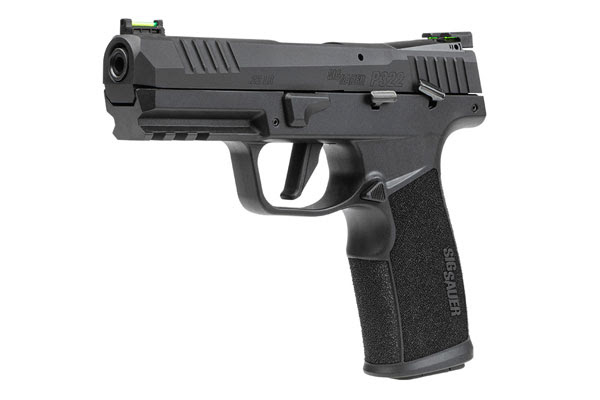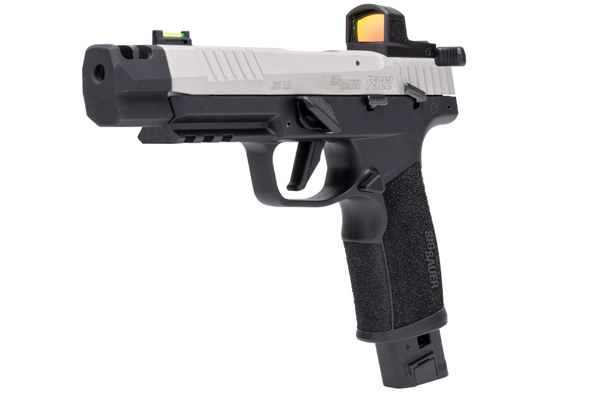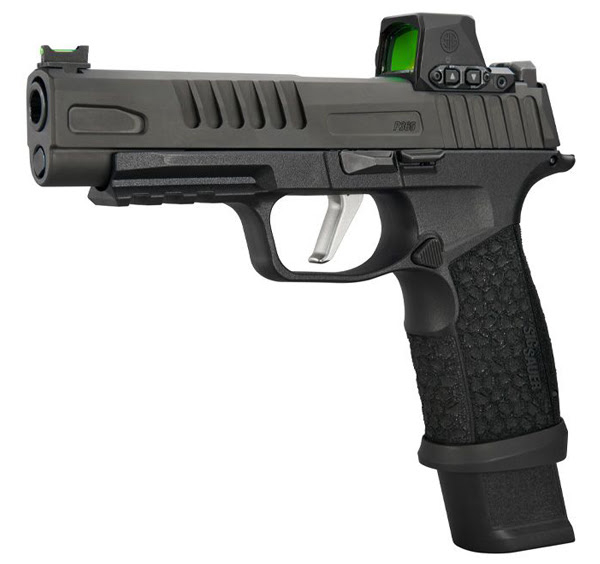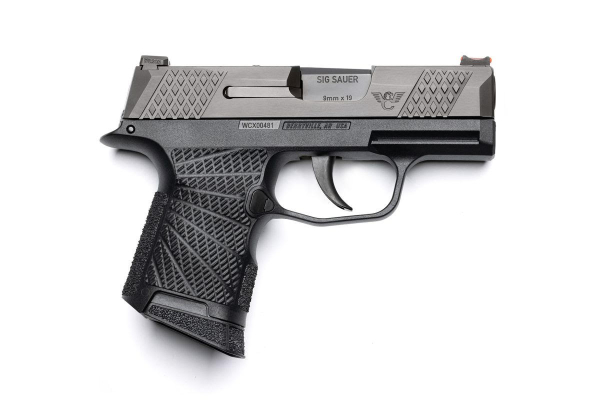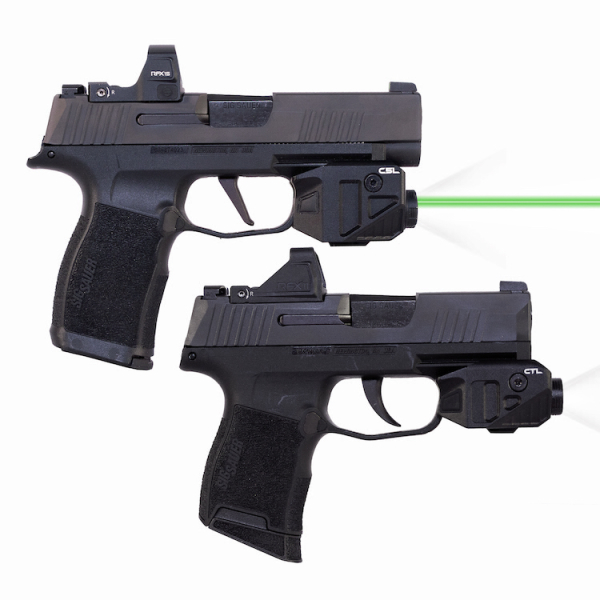SIG P322 – Rimfire Revolution?
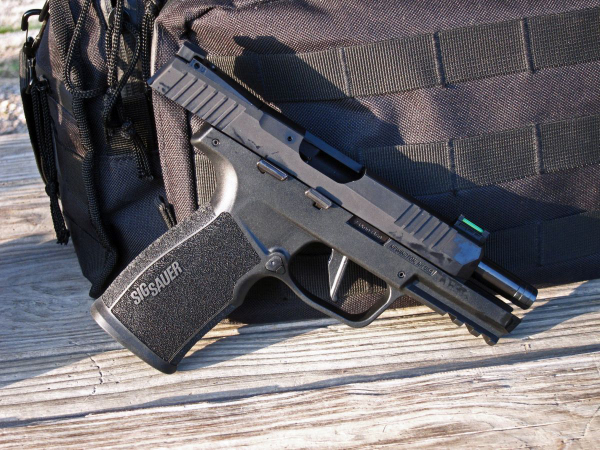 Knowing the propensity of folks to add muzzle devices to guns including 22-trainers, they gave users a threaded barrel – covered, so you could get the gun apart easily if you’re not adding stuff to the front of the gun. They supplied the thread adapter so you could add stuff to the front of the gun.If you want even more gear slung onto the front of the pistol, there’s a section of rail for a dust cover for your favorite gun light, laser or whatever.They use fiber optic sights front and back, as well as making the rear sight adjustable for windage and elevation. Or you can simply remove the rear sight/cover plate and attach an optic … like the SIG ROMEOZero (without any adapter plates).After the visual shooting solution, you may find the trigger isn’t to your liking – if you don’t like the flat-faced trigger. It seems that’s the ‘in’ thing, but they provide a curved trigger shoe for those who are flat trigger averse.The slide stop and manual safety (calm down, it’s a rimfire trainer) are bilateral, appearing on both sides of the pistol. The magazine release button can be reversed.
Knowing the propensity of folks to add muzzle devices to guns including 22-trainers, they gave users a threaded barrel – covered, so you could get the gun apart easily if you’re not adding stuff to the front of the gun. They supplied the thread adapter so you could add stuff to the front of the gun.If you want even more gear slung onto the front of the pistol, there’s a section of rail for a dust cover for your favorite gun light, laser or whatever.They use fiber optic sights front and back, as well as making the rear sight adjustable for windage and elevation. Or you can simply remove the rear sight/cover plate and attach an optic … like the SIG ROMEOZero (without any adapter plates).After the visual shooting solution, you may find the trigger isn’t to your liking – if you don’t like the flat-faced trigger. It seems that’s the ‘in’ thing, but they provide a curved trigger shoe for those who are flat trigger averse.The slide stop and manual safety (calm down, it’s a rimfire trainer) are bilateral, appearing on both sides of the pistol. The magazine release button can be reversed.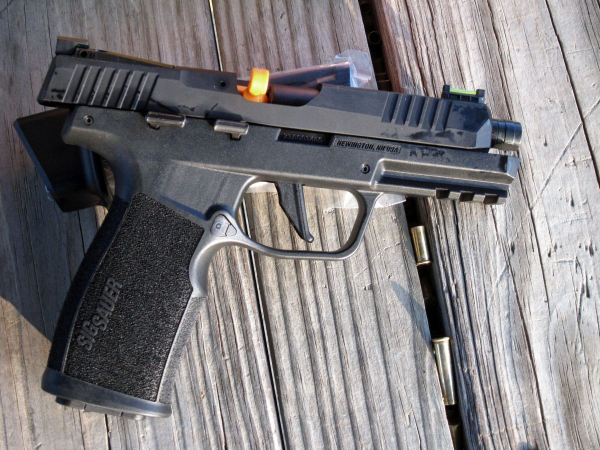
 The gun, while appearing to be a striker-fired job, is (like most rimfire trainers of my acquaintance) hammer-fired. They call it ‘single-action,’ meaning that the press of the trigger only releases the hammer from the sear allowing the gun to fire. There are front- and rear cocking serrations, a fluted chamber (don’t recall seeing those since HK centerfire autoloaders) and the gun ships with a magazine-loading assistant.That’s likely to be handy when you’re loading twenty-round magazines. And, 25-round magazines are apparently being made as well.
The gun, while appearing to be a striker-fired job, is (like most rimfire trainers of my acquaintance) hammer-fired. They call it ‘single-action,’ meaning that the press of the trigger only releases the hammer from the sear allowing the gun to fire. There are front- and rear cocking serrations, a fluted chamber (don’t recall seeing those since HK centerfire autoloaders) and the gun ships with a magazine-loading assistant.That’s likely to be handy when you’re loading twenty-round magazines. And, 25-round magazines are apparently being made as well.
That’s gotten you caught up to date on the new gun. Except for the price. While it wasn’t in stock at Cabela’s, where I looked online, the price was listed as just under $400.
I’m not sure what more you’d want for that price.
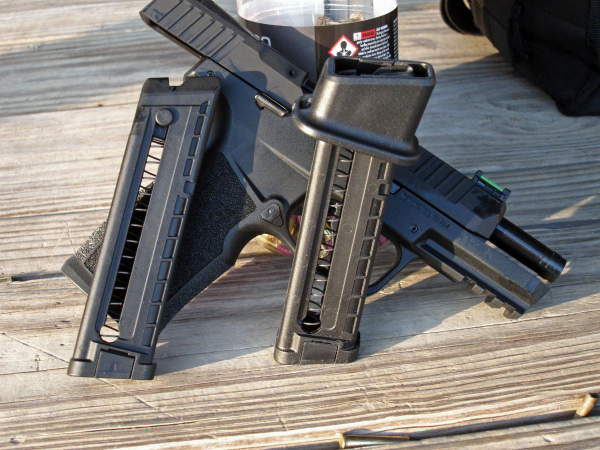
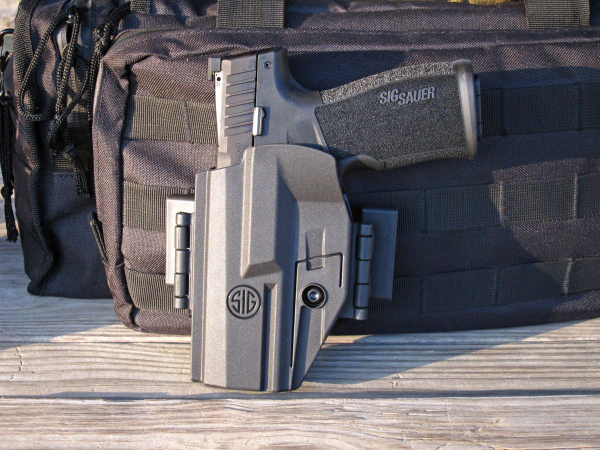
The holster – available from SIG – is an injection-molded unit. It can be used by right- and left-handed shooters and can be configured to be worn inside the waistband or outside. That’s a lot for the online ca-$30 price tag.
The P322 is made – was designed, engineered and produced – in New Hampshire, USA. It’s not a third-party gun made in Europe. SIG put a lot on this gun.
All that’s left is to shoot it. I took the opportunity to sneak out to the club early on a weekend – never the smartest time to be there. While a collegial group was ready to shoot on the High Power range, the rimfire range was empty. I set targets on the closer backstop (around 20 yards) and set out to see if the new pistol would shoot.
Using a range bag as a rest, I tried CCI CLEAN-22 40 gr. ammo, Fiocchi Standard Velocity, Winchester Super-X “Super Speed RN” and Winchester Super-X PowerPoint ammo. The groups ranged from 2-3 inches for five-shot strings, with the “best three of five” going into 1-1.5” groups.
The concerning thing was that the typical group was six-inches low and a couple of inches to the right. I worked on adjusting elevation, assuming that windage was my addressing the trigger and not a gun issue.
After my first few attempts to run elevation UP, I read the instructions. It seems I was moving the adjustment up far enough that the rear sight was returning to actual zero, the base of elevation. Being more careful in my adjustment, I found the next group clustered into the head box of the 12” x 18” Birchwood Casey “EZE-Scorer” BC IPSC Practice Target. That’s about a 4”x4” box, but I didn’t use nearly all of it.
Accuracy Test
| Ammo Brand, Type | Five Shot Group Avg. | Best 3/5 | Notes |
| CCI CLEAN-22 40gr. | 2” | 1 1/8” | |
| Fiocchi Standard Velocity | 2 5/8” | 1 ¼” | Horizontal string; one group was 7/8” for 3/5 |
| Winchester Super-X Super Speed RN | 2 ½” | 1 ½” | Consistent groups |
| Winchester Super-X PowerPoint | 2 ¾” | 1 1/8” |
I decided to try the “15-round Drill” to determine if I needed to adjust the sights for windage. The distance was a bit far, but this was a fixed firing line range. I had to play this one for distance. Using the BC IPSC practice target, I’d load with fifteen rounds – it’s handy that this is a 20-round capacity gun – and fire the following five-shot strings: (1) five rounds, dominant hand unsupported; (2) five rounds, nondominant hand unsupported, (3) five rounds nondominant hand supported (two-handed).
In this way I could see if my bench rest groups, fired right-handed, were forced right by grip or trigger press.
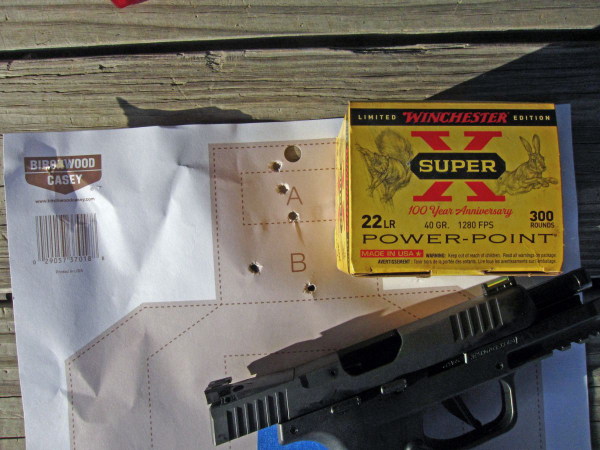
Editor’s Note: Today’s feature first appeared in The Shooting Wire. We’re (still) waiting on our P322 -but Rich Grassi’s already spent trigger time on his test unit. It’s safe to say that 2022 really is the year of the reemergence of the venerable .22 rimfire. Now if we only had more ammo….
The first time I ran the drill, I let a round get away over the target’s right shoulder (shot left). I’m used to shooting guns with tougher triggers. I had one low “C” zone (called) and the rest were centered in A and C zones.
The second attempt was shot with the CCI CLEAN-22 load. I had a D-zone left, two D-zone hits right and the rest were centered in the A and C zones. I’d loaded sixteen rounds this time and tried that last round two-handed with the dominant hand, shooting for the “A” zone in the head box – a box that’s 2 ¼” wide and 1 1/8” high. That one round struck just right of the “A” printed in the box, perfect for windage.
So, the tendency to shoot right is largely a grip/trigger issue with the right hand. I’ll have to sort that out.
This was the first trip with the new heater. Next time it’ll be holster drills.
I’ll let you know what happens.

